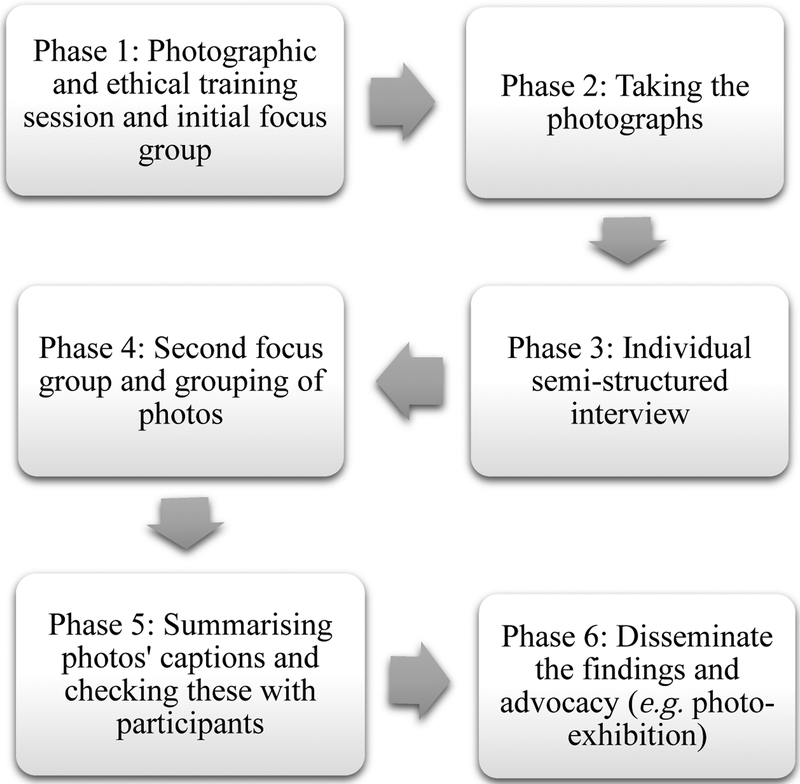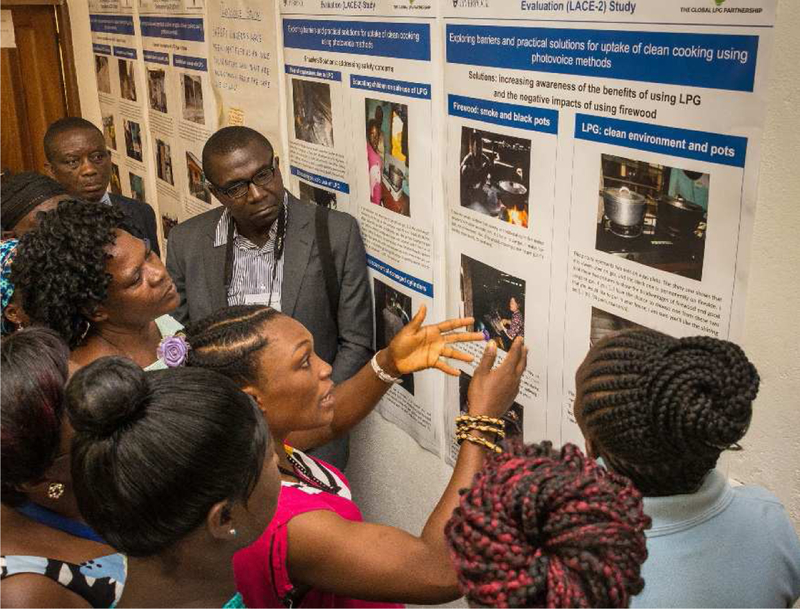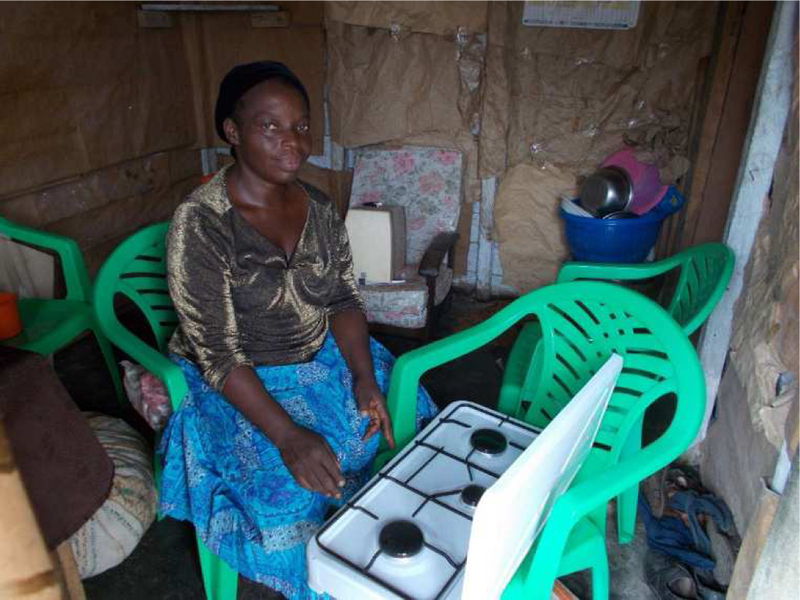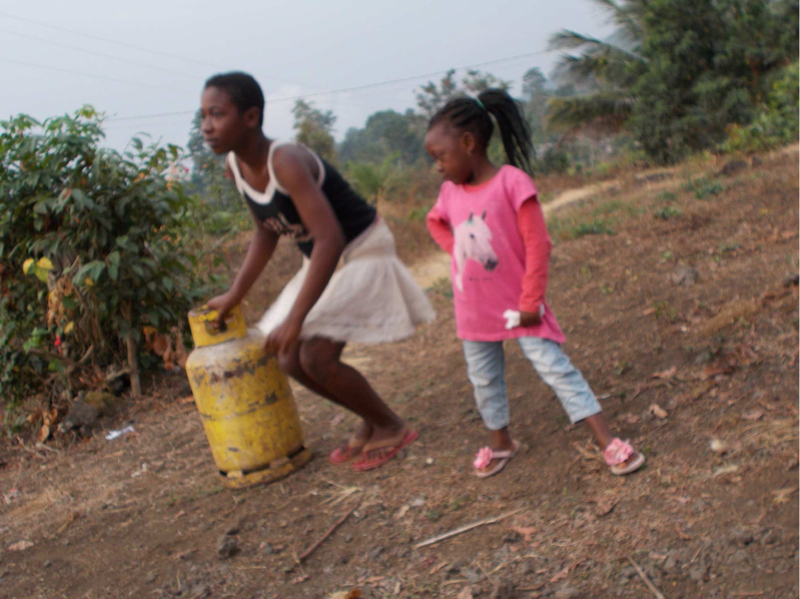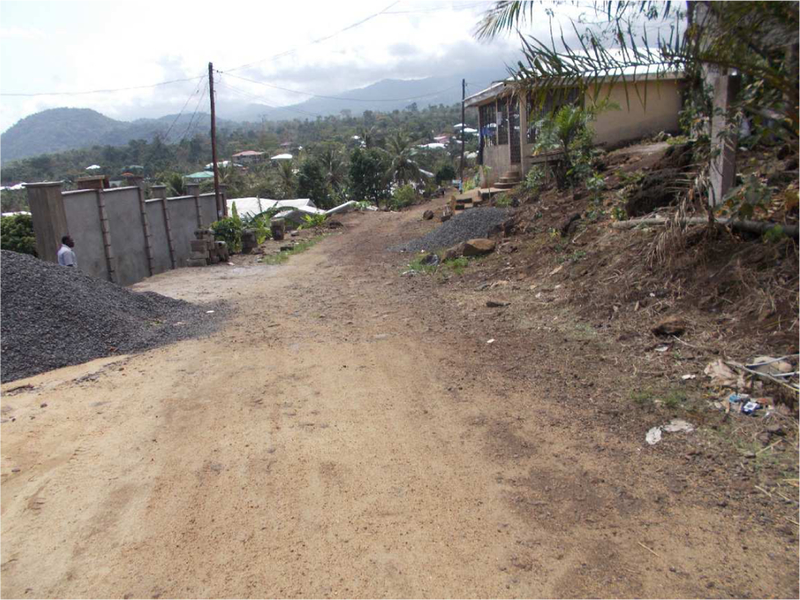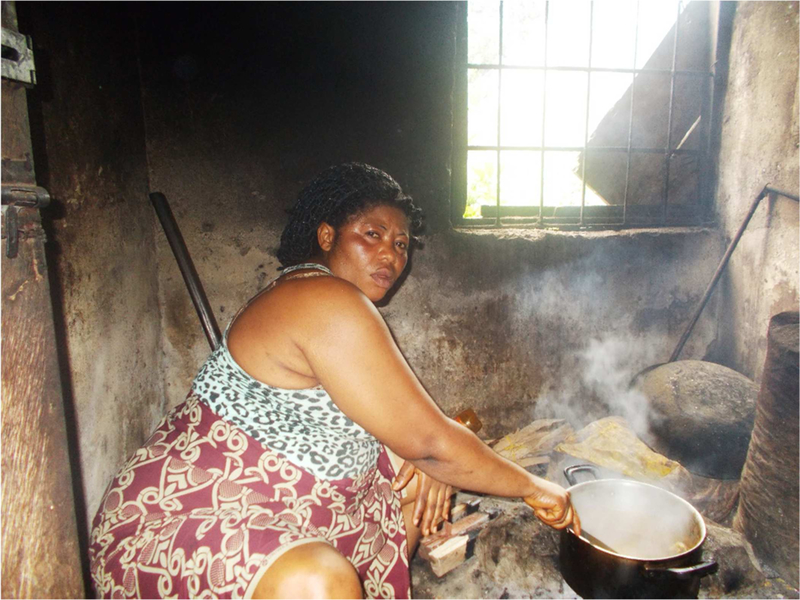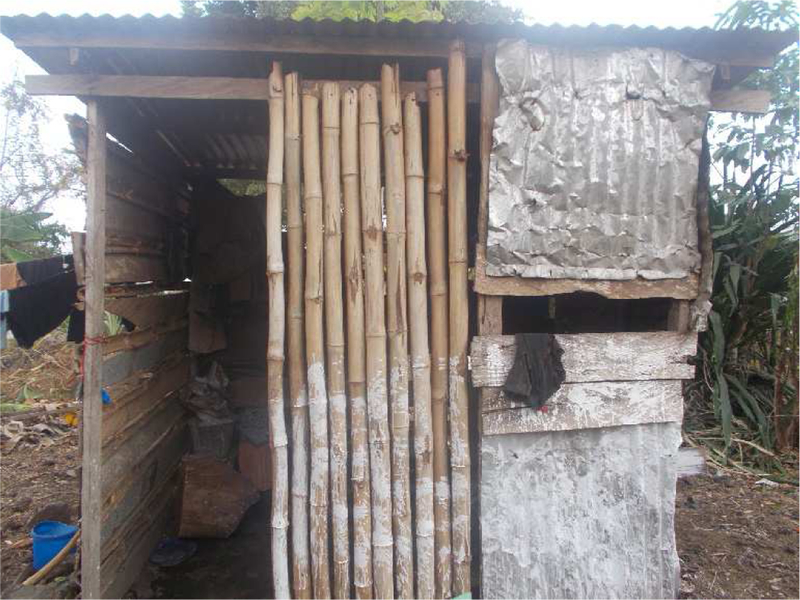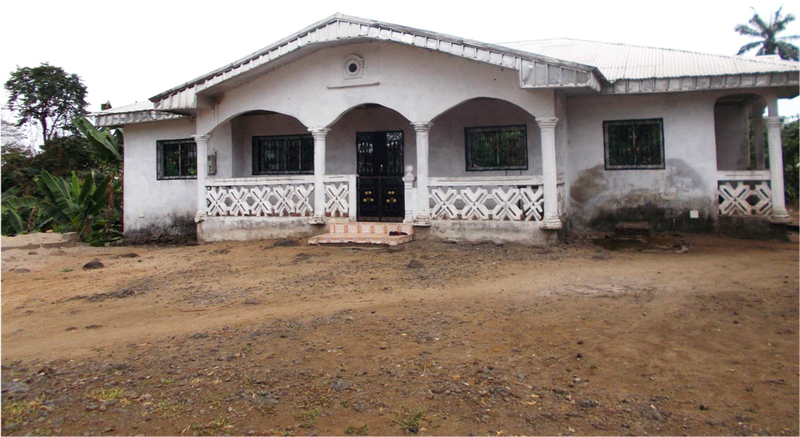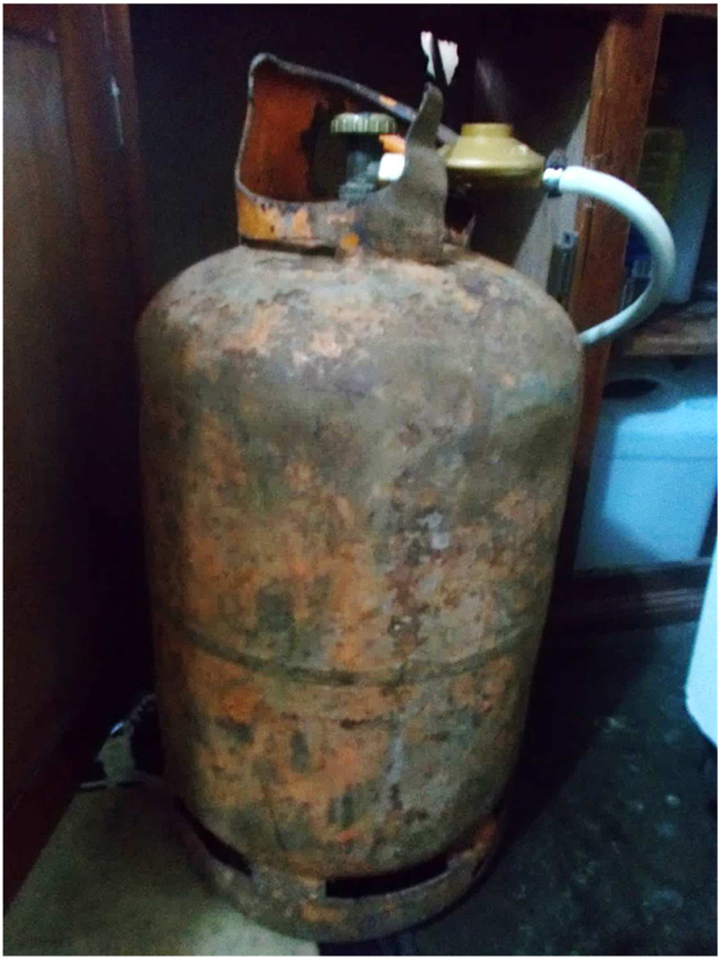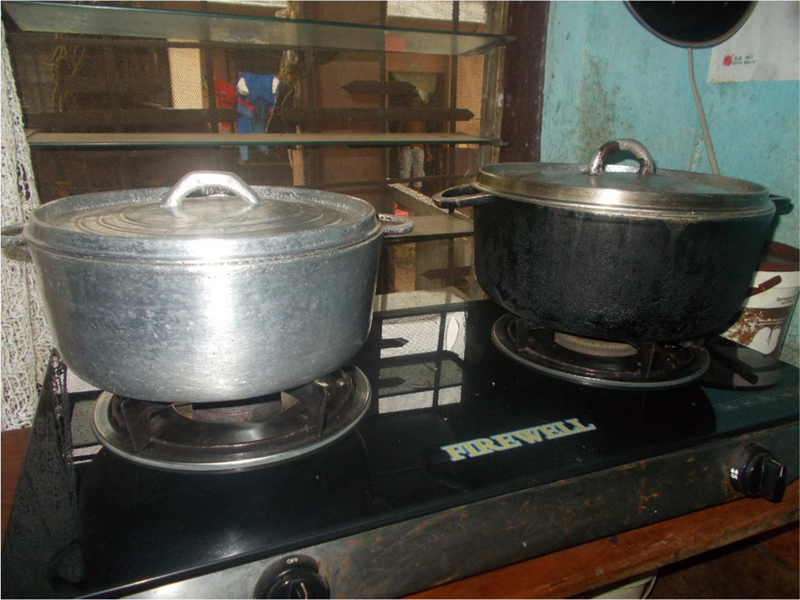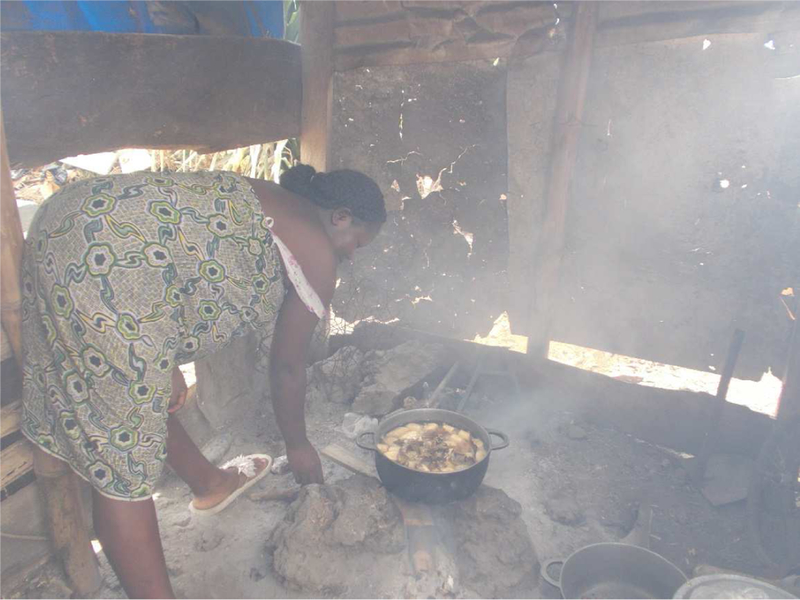Abstract
Each year up to 2.6 million people die prematurely from household air pollution (HAP) due to cooking with polluting fuels such as wood and charcoal, particularly in low and middle-income countries (LMICs). The World Health Organisation recommends scaling the adoption of clean fuels to improve maternal and child health. Liquefied Petroleum Gas (LPG) represents a scalable clean fuel that provides health and environmental benefits when used for household energy in LMICs. In Cameroon, over 70% of people rely on biomass for cooking, and the Government aims to increase LPG use from < 20% to 58% by 2030. Supporting households make this transition requires involvement of multiple stakeholders and an understanding of perspectives from the community’s perspective. We used visual participatory methods ‘photovoice’ to explore households’ perceptions of factors influencing the uptake of LPG for cooking in South-West Cameroon. Two groups of participants from rural (n=7) and peri-urban (n=8) areas photographed subjects they identified as preventing and facilitating LPG uptake in their communities. Subsequently, individual interviews (n=15) and group discussions (n=5) explored participants’ reflections on the photographs. Thematic analysis was conducted using NVivo 10 software. The main barriers identified included difficulty in affording the initial LPG equipment and ongoing refills, scarcity of LPG retail shops and refills, and safety concerns. Facilitators included (i) increasing awareness of the benefits of LPG (e.g. health), (ii) increasing retail outlet density in rural areas, (iii) addressing safety concerns (e.g. replacing damaged cylinders), and (iv) reducing the price of LPG refills. Participants presented their photos at a public exhibition, which generated discussions with key stakeholders (e.g. government ministries) about how best to assist communities in this transition. Photovoice was found to be an innovative and effective approach for exploring how to advance equitable access to LPG from a community perspective and successfully engage with key stakeholders.
Keywords: Photovoice, qualitative research, community-based participatory research, household air pollution, LPG, adoption, Cameroon, cooking
1. Introduction
Each year up to 2.6 million people die prematurely from household air pollution (HAP) arising from use of solid fuel for domestic energy, particularly in low and middle-income countries (LMICs) (HEI Household Air Pollution Working Group, 2018). HAP occurs when fuels such wood and charcoal, are burned indoors for cooking or heating. In 2016, HAP accounted for 4% of all premature deaths (Global Burden of Diseases (GBD) (HEI Household Air Pollution Working Group, 2018). HAP is a recognised risk factor for several diseases affecting both adults (cardiovascular disease, lung cancer, chronic obstructive pulmonary disease) and children (pneumonia) (Dherani et al., 2008; Gordon et al., 2014; Smith et al., 2014).
To address these challenges, the WHO Indoor Air Quality Guidelines recommend the adoption of clean fuels at scale (WHO, 2014). Liquefied Petroleum Gas (LPG) represents a widely available and scalable clean fuel that provides health and environmental benefits when used for household energy in LMICs (Rosenthal, Quinn, Grieshop, Pillarisetti, & Glass, 2018). LPG is already used as primary or secondary cooking fuel by more than 2.5 million people globally (International Energy Agency, 2017) and several countries have recently embarked in large-scale efforts to promote LPG uptake for their populations (Thoday, Benjamin, Gan, & Puzzolo, 2018). Although other clean fuels are available (e.g. electricity or piped natural gas), they are currently impractical or more expensive to deploy in these disadvantaged contexts (WHO, 2014). Despite being cleaner than traditional solid fuel stoves, ‘improved biomass cookstoves’ have shown limited effectiveness in reducing HAP to levels which are able to produce significant health improvements (Mortimer et al., 2017).
Many factors, such as household finances and availability of LPG, however, impact on the transition to LPG (Quinn et al. 2018). For households that do not use LPG, particularly with low-incomes or who have wood freely available to gather, the upfront costs of LPG equipment act as a primary barrier to adoption (Leeuwen, Evans, & Hyseni, 2017). Among households that currently do use LPG in LMICs, a frequently reported issue is the parallel use of traditional stoves with solid fuel – a practice known as ‘fuel stacking’ (Hollada et al., 2017). Fuel stacking occurs for a variety of reasons (e.g. fuel costs and food taste preferences), and has important implications for supporting households to use LPG exclusively, necessary to significantly reduce HAP (Quinn et al., 2018).
Understanding around factors influencing the transition to LPG has been structured - in the form of a ‘LPG logic model’ according to (i) industry and services, (ii) consumer demand (iii) pricing and costing and (iv) user and community perceptions (Rosenthal et al., 2017). This model builds on a systematic review by Puzzolo et al. (2016) where several factors have been identified as operating at different levels including international (e.g. LPG import price), national government (e.g. ability to enforce rules and safety standards) and community and household level (e.g. needs). To facilitate communities to make this transition these structures need to be recognised as operating within the same system, and issues tackled together by working across different levels, with strong government support (Quinn et al., 2018; Rosenthal et al., 2017). Despite recognising the importance of community perceptions, the systematic review by Puzzolo et al. (2016) did not identify any qualitative studies related to LPG at that time and highlighted the need to conduct qualitative research to address this gap and better understand community perspectives. There is now a growing recognition for the need to develop programmes able to promote continued LPG use, in addition to adoption to maximize health and environmental benefits. Exploring community perspectives is needed to disentangle the key motives for people not adopting or using LPG on a sustained basis, and ultimately inform policy.
Moreover, until recent years, qualitative research has focused on adoption of ‘improved cook stoves’ (Ardrey, Desmond, Tolhurst, & Mortimer, 2016; Rehfuess, Puzzolo, Stanistreet, Pope, & Bruce, 2014; Stanistreet, Puzzolo, Bruce, Pope, & Rehfuess, 2014). Only a few studies (Hollada et al., 2017; Labriet & Alfaro, 2015; Rehfuess et al., 2014) have explored households’ perceptions of factors impacting on LPG uptake in LMICs, none of which were in Sub-Saharan Africa, where reliance on solid fuels is prevalent and policies to promote access to clean household energy are still scarce.
Driven by these needs, community-based participatory research (CBPR) could be an effective approach in (i) engaging more actively with community members in the field of clean household energy, (ii) understanding how best to facilitate adoption and continued use of LPG from a community perspective, and (ii) reaching key stakeholders across the different levels of the LPG supply chain, so that the users’ voice and needs can directly influence interventions/policies to address local needs. CBPR is an approach that promotes community participation, social action, and collaborative inquiry, and is often employed to tackle public concerns (Castleden, Garvin, & First Nation, 2008; Israel et al., 2005; Minkler, 2005).
Photovoice, initially developed by Wang & Burris (1997), originates from a CBPR approach, and is a collective visual method wherein people use photographs to represent community issues important to them. Photovoice is grounded in Freire’s approach to education for critical consciousness (1970, 1974), which suggests that the visual image is an important instrument for (i) stimulating individuals to reflect about their community and (ii) advocating for change. In photovoice, the production of knowledge is in the hands of participants, who determine what to represent in a photograph, and gradually become ‘interpreters of the world’ (Carlson, Engebretson, & Chamberlain, 2006). This process is strengthened by collective discussions, where people share the meanings of their photographs and reflect on their community (Wang & Burris, 1997). Photographs and accompanying captions presented through an exhibition are used as an advocacy tool to bring participants’ voices to the attention of key stakeholders (e.g. policy makers), raise their awareness about the issues identified, so that they can stimulate change (Hergenrather, 2009).
1.1. Study context
Cameroon is a low middle-economy with a Gross Domestic Product worth 34.80 billion US$ in 2017 (Trading Economics, 2018). Despite the recent health, and economic developments, over 70% of people still rely on solid fuels (primarily wood) for cooking (more than 90% in rural areas) (Enquête Démographique et de Santé et à Indicateurs Multiples du Cameroun 2011, 2012). As of 2011, 18% of peri-urban households reported to use LPG primarily for cooking. To address this issue, in 2016 the Cameroon Government announced the first national Clean Cooking LPG Master Plan – the first step needed to expand the LPG market. By improving LPG supply and availability in cylinders, the Government aims to increase usage of LPG from less than 20% to 58% of the population (around 18 million people) by 2030 (GLPGP, 2016). Achieving this goal will help to solve the issues of health, deforestation, energy security, and climate associated with relying on biomass for fuel (Bruce et al., 2018). It will also contribute to achieving Sustainable Development Goal (SDG) 7 on “ensuring universal access to affordable, reliable and modern energy services” and SGD3 on “better health and well-being for all”. Cameroon operates the safe and sustainable ‘branded cylinder recirculation model’: LPG marketers own the cylinders and are responsible for safety checking and replacement, and households exchange their empty cylinders of a specific brand for a filled one of the same brand. The price of LPG is uniformly subsidised in Cameroon; a 12.5kg cylinder refill cost CFA 6,500/US$ 12 (equivalent to US$ 0.98 per kg of LPG), with minor cost variations due to added transport costs.
1.2. Study aims
This paper reports on a photovoice study that engaged with community members in South-West Cameroon to: (i) identify factors influencing the uptake and continued use of LPG for cooking from a community perspective; (ii) increase individual and community awareness of the benefits of switching to clean fuel; and (iii) facilitate critical dialogue with key stakeholders (e.g. policy makers) about how best to advance uptake of clean cooking and improve health.
2. Methods
The study was conducted from February to September 2017 as a part of the ‘LPG Adoption in Cameroon and Evaluation (LACE)’ program, a series of mixed methods studies examining how to achieve and sustain LPG transition in Cameroon. Ethical approval was obtained from the University of Liverpool Research Ethics Committee and Comite Regional D'Ethique de la Recherche pour la Sante Humaine du Centre (Cameroon National Ethics Committee) in February 2017.
1.1. Study setting and participants
We conducted the study in the South West Region of Cameroon (Anglophone coastal region), in the locations of Buea and Limbe − one community selected from each location. In Limbe (peri-urban), availability of LPG refills and supply tends to be more consistent than Buea (rural), located approximately 15 km from Limbe, where there is a lack of LPG retail outlets. A cross-sectional household survey conducted for the LACE program (Pope et al. 2018) showed that household wealth (income and asset ownership) was significantly related to LPG use, with greater LPG use in peri-urban settings. These households had greater occupations that paid in cash and monthly income and were more likely to own assets (e.g. access to electricity) than rural households. By contrast, rural households were more likely to be employed in farming with lower incomes and seasonality affected earnings (e.g. timing of crops). Study participants (n=15) were purposively selected from a sub-set of households that took part in a cross-sectional household survey for the LACE study (n=300) (Pope et al. 2018). The recruitment comprised two stages. 1. Based on the survey data, we generated a list of households (head cooks) stratified by fuel use: those who reported (i) exclusively using wood fuel (defined ‘non-LPG users’) and (ii) using both wood and LPG (defined ‘mixed users’) for cooking. The non-LPG users were predominantly from the rural community, and mixed users from the peri-urban community. 2. From this list, fieldworkers recruited participants ensuring a range of ages, gender, and incomes, to incorporate various perspectives. They further assessed participant eligibility through a set of questions, including current use of LPG (to assess if it changed since the survey response) and a desire to adopt or use LPG exclusively (we were interested in encouraging participants to identify solutions to LPG uptake in their community). We anticipated a more female representation of the sample, as based on traditional gender roles, women living in Sub-Saharan Africa are primarily responsible for cooking and child rearing (Austin & Mejia, 2017). In Cameroon, women tend to be head cooks, while traditional male occupations in the study region include farming and fishing.
To best promote effective group dynamics, fieldworkers selected between six and ten participants per community.
2.2. Procedures
Three trained fieldworkers collected the data. Their knowledge of the local culture proved crucial in informing parts of the study and in facilitating the research process. For instance, fieldworkers reported that participants were not used to sharing their views on their community and therefore they may have found it challenging to identify issues and potential solutions. We worked with the fieldworkers to ensure that the questions were phrased in such a way that prompted participants to think of issues/solutions, and the value of their views was stressed thorough the process.
We slightly adapted Wang & Burris’ (1997) original methodology consisting of just focus group discussions (FGDs) to incorporate a semi-structured interview (SSI) in the process (Nykiforuk, et al. 2011 replaced FGDs with SSIs in their methodology) (represented graphically in Figure 1). Based on previous experience, the lead researcher found that the additional SSI helped to (i) build a rapport with the participant and (ii) explore the individual perceptions of the photographs in a greater depth than in FGDs – typically focused on stimulating discussion (Ronzi et al. 2016). We arranged two photovoice groups, one in each community (demographics presented in Table 1), which lasted approximately one month. Each group took part in three sessions: two FGDs (Phase 1 and 4, Figure 1) and a SSI (Phase 3), conducted in the local language (Pidgin) and audio recorded with permission. Field notes were collected on these occasions (Merriam & Tisdell, 2015). Both FGDs took place in community halls, while the interviews took place in participants’ homes. In recognition of their time, participants received a framed photograph of their choice. Phase 1–5 (Figure 1) were repeated separately for each group.
Figure 1.
Phases of the photovoice process. Adapted from Wang & Burris (1998), Nykiforuk, et al. (2011) and (Ronzi et al. (2016))
Table 1.
Details of participants.
| Group | Geographical area | N | Gender | Total Monthly Household Income** | Age group | |
|---|---|---|---|---|---|---|
| M=male F=female |
25,000 CFA (US$ 43,5) is
poverty threshold; <50,000 CFA (<US$ 87) is below national average monthly household income; 50,000 CFA (US$ 87) is national average monthly household income; >100,000 CFA (>US$ 174) is above national average monthly household income. Exchange rates as of December 2018. |
|||||
| 1 Non-LPG users |
Rural | 7 | F=6 M=l |
<25,000
CFA: 4 26,000–50,000 CFA: 1 51,000–100,000 CFA: 1 >100,000CFA: 1 |
Income
1 Income 2 Income 3 Income 4 |
18–24:
1 25–40:2 41–59:2 60+: 2 |
| 2 Mixed-users |
Peri-urban | 8* | F=7 M=l |
<25,000
CFA: 1 26,000–50,000 CFA: 5 51,000–100,000 CFA: 1 >100,000CFA: 1 |
Income
1 Income 2 Income 3 Income 4 |
18–24:0 25–40:5 41–59:3 60+: 0 |
| Total | 15 | M=2; F=13 |
||||
Note: N.2 participants did not attend the second focus group but participated in a paired interview.
Note: To simplify, the total Household Monthly Income has been split into 4 categories, from poverty threshold (Income 1) to above national average Household Monthly Income (Income 4).
In Phase 1, the fieldworkers offered an overview of the project, gave each participant a digital camera, and conducted the photographic and ethical training, including photo ownership and ethics of individuals appearing in photos. Following the ethics guidance developed by Wang & Redwood-Jones (2001), participants received an ‘Acknowledgment and release form’ and were instructed to obtain written consent from any person who was photographed. Fieldworkers explained the ‘rules’ regarding when consent was required (e.g. individual or group is ‘featured’) and when it was not (e.g. a crowd of people) and advised to avoid taking photographs of individuals under 18, unless they were relatives. Written permission to use photographs for dissemination of results was obtained from participants (Evans-Agnew & Rosemberg, 2016). Subsequently, participants discussed in groups their general views of cooking with wood and LPG use in their community. This discussion served as a stimulus to encourage participants to think about potential subjects they could photograph (Phase 2).
In Phase 2, participants took photographs over ten days. Participants were asked to photograph ‘any meaningful object/person/aspect of their community that represented a barrier or facilitator to starting cooking or to cook more with LPG. They were not given examples of potential photos, as we wanted to limit the researcher’s influence over the participants’ choice of photographs (Evans-Agnew & Rosemberg, 2016). The fieldworkers visited each participant to check on the photo taking-task and provided technical assistance if required (Musoke, Ndejjo, Ekirapa-Kiracho, & George, 2016).
Phase 3 included a SSI. Each participant, who had not seen the photographs before the interview, selected the six photos they thought best represented factors influencing LPG uptake in their community. To elicit meaningful responses, fieldworkers asked a set of questions (Appendix A) informed by the SHOWeD technique (Wang, Yi, Tao, & Carovano, 1998). The questions focused on the meanings and importance of the photographs. Moreover, participants discussed whether there was any photograph that they wanted to take, but for various reasons were unable to, to identify unrecorded issues of importance to them (Hodgetts, Chamberlain, & Radley, 2007). Overall, 90 photographs were selected by the two photovoice groups.
Phase 4 started with a FGD, wherein each participant presented their chosen six photographs and commented on each other’s photos, reflecting on similarities and differences between them. Subsequently, they sorted the photographs into two clusters (barriers and facilitators to LPG uptake) and summarised the meanings of each photograph onto flipcharts. They later made a list of priorities that needed addressing (e.g. replacing damaged cylinders). Fieldworkers ensured all participants were involved in the process by encouraging everyone to ask questions about the photographs presented and assisting participants in writing up what was discussed onto the flipcharts. At the end of the session, participants chose which photographs they wanted to display at the photo-exhibition (Diez et al., 2016).
In Phase 5, SR wrote a commentary based on the participant’s original description of the photographs (from the transcripts). To ensure the captions accurately reflected the meanings, each participant reviewed and approved the commentaries prior to the photo- exhibition (Evans-Agnew & Rosemberg, 2016).
In Phase 6, a photo-exhibition (September 2017) was conducted in the study location. Following discussion with participants, the event was held at a central Museum of social significance with good access to public transport. Fifty-one photographs were presented, with each participant having between three and four photographs displayed. Photographs were organised by themes and subthemes, which were reviewed and approved by participants. Participants presented their photographs and stories to 100 people including (i) community leaders and mayors of the communities, (ii) local representatives from government ministries of Environment, Energy, and Health, (iii) LPG marketers, (iv) local and national newspapers and (v) community members. The photo-exhibition provided a forum for participants to raise awareness about these issues to influential stakeholders (Figure 2) and discuss how best to assist communities in transitioning to clean cooking. The event was evaluated with a short survey, and observation notes were taken to capture the interactions between participants and stakeholders. Findings of the impact of the event will be presented in a forthcoming paper.
Figure 2.
Example of a participant explaining her photo to key stakeholders at the event.
2.3. Data analysis
Interviews and FGDs were transcribed verbatim and translated into English; the transcripts were doubled-checked for accuracy. Analysis was conducted using NVivo 10 software (QSR International, 2014). We identified themes and subthemes from the transcripts, drawing on techniques from thematic analysis (Miles & Huberman, 1994). The data analysis process began after Phase 4 (Figure 1) was completed in both groups. It was informed by Drew & Guillemin’s (2014) analytical framework of ‘interpretive engagement’ for participants-generated images, and included the following steps:
Participants’ analysis recorded onto the flipcharts was used to develop an initial set of codes for the thematic analysis. This material consisted of a list of photographs categorised into barriers and facilitators, a summary accompanying each photograph, and a list of key priorities that needed addressing.
Based on this preliminary list of codes, the analysis progressed with line-by-line coding of the SSIs and FGDs transcripts, wherein additional codes were developed. [SR] read, coded, and analysed the transcripts, for which [LH] with 20% double-coding. [SR] & [LH] compared the codes and discussed any discrepancies.
The analysis progressed with development of categories, and organisation of categories into themes and sub-themes. We looked for similarities and differences between photographs (Bisung, Elliott, Abudho, Schuster-Wallace, & Karanja, 2015), which we grouped into sub-themes that emerged through the thematic analysis. Although photographs contextualised participants’ narratives (Belon, Nieuwendyk, Vallianatos, & Nykiforuk, 2014), we did not code the photographs’ content separately from the transcripts – according to Wang & Burris (1997), the meaning of the images resides in the ways that participants interpret those images.
The fieldworkers met with each participant, who checked that the findings emerging from the thematic analysis reflected what emerged from the photographs and discussions. Selected examples of how the participants’ analysis (of barriers, facilitators, and priorities) is linked with the findings identified in the thematic analysis is shown in Appendix B.
Finally, we presented the preliminary findings at the photo-exhibition event (Phase 6, Figure 1). We displayed some bubble posters presenting open questions arising from the main findings (e.g. what are your opinions about availability and accessibility of LPG?). Attendees (community and stakeholders) made comments with post-it notes. This helped to verify the accuracy of the findings and integrate any external perspectives relating to the issues raised (Bisung et al., 2015).
3. Results
Participants took a total of 586 photographs (313 peri-urban; 273 rural), with an average of 25–30 photographs per participant. Table 1 presents demographic details of the 15 participants.
The findings that emerged centred on two main themes: barriers and facilitators for adoption and continued use of LPG. Some findings were similar between non-LPG users and mixed users, such as safety/security concerns due to poor housing and old equipment, the importance of raising awareness of the negative effects of firewood, and the benefits of LPG. However, rural households identified affordability of and accessibility to LPG as the main factors preventing their adoption. Peri-urban households, instead, emphasised issues related to accessibility of LPG refills as preventing their continued use of the fuel. In terms of differences according to higher or lower income, rural households generally had lower household income (Table 1) than peri-urban households, and this was reflected in the findings, with financial difficulties emerging as an important barrier to LPG adoption for rural households. Female and male participants, as well as younger and older participants, took similar photographs, and expressed consistent views about perceived barriers and facilitators of LPG use.
It is noteworthy that, when reflecting on their own experiences of fuel use, some participants identified aspects that related to themselves, and others, identified aspects that related to the wider community.
3.1. Key identified barriers to adoption and continued use of LPG
Amongst the barriers to LPG uptake or use, participants described (i) the high cost of initial purchase of the LPG equipment, (ii) poor access to refills due to long distances, (iii) poor availability of LPG cylinders at retail shops, (iv) lack of access to certain cylinder brands and resulting in use of wood and (v) safety concerns due to poor housing and old LPG equipment.
3.1.1. Financial impediments in affording LPG
Despite willingness to use LPG, all non-users reported the prohibitive costs of initial purchase and/or refills as a barrier. Figure 3 shows a woman with a three-burner LPG stove but without a gas cylinder, as she was unable to afford the refill.
“I took this picture because this woman has a gas plate, but no gas bottle. […] without the gas bottle, the plate is useless. […] this woman is really interested in having gas, but she is financially down, and business is slow.”
(P7, SSI, F, Rural, age 66, Income 4)
Figure 3.
Example of financial impediments preventing LPG use (P7, F, Rural, age 66, Income 4)
According to non-LPG users, the cost of the initial equipment was pitched against competing expenses such as providing food for their family and supporting children to go to school.
“Some of us have given birth to 8, 9, 10 children, so we cannot remove thirty to thirty-six thousand [francs]1 to go and purchase LPG kits when there is no food in the house.”
(P6, FG1, group 1) 1[30,000 CAF= 52.1US$, exchange rates as of December 2018]
Some participants reported using both LPG and wood for cooking to make LPG last for longer, particularly when cooking large quantities of food or for foods taking a long time to cook.
“I am doing economy, since I don’t want my gas to get finished fast. I use wood to cookmy food and then I use gas to reheat the food so that the gas can stay for long […].”
(P1, FG1, F, Peri-urban, age 28, Income 2)
According to some non-LPG users, financial support (e.g. access to micro-loan schemes or the possibility of paying in instalments) could help them to afford the initial equipment and refills.
“Gas is good though many [people] are complaining of financial difficulties. If you […] can supply gas to them and they pay in instalments, it will be good.”
(P5, SSI, F, Rural, age 60, Income 1)
3.1.2. Transportation costs to access refills due to long distances
Most non-LPG users reported the scarcity of retail shops selling LPG in rural areas resulting in both time and financial costs in accessing LPG, as shown in Figure 4 and the quote below.
“This is a picture of a child with an [empty] gas bottle waiting to board a car to go and buy gas. [She waited] for about 2 hours. [This picture shows] the difficulties in obtaining gas due to distance and transport cost and, also the uncertainty of gas in other places. If we had a shop that sells gas, [this would] reduce transport costs.”
(P2, SSI, F, Rural, age 28, Income 1)
Figure 4.
Example of added transportation costs and time lost due to lack of retail shops (P2, F, Rural, age 28, Income 1)
Most non-LPG users and one mixed user represented long distances to procure LPG by photographing empty roads (e.g. Figure 5). They also reported that poor road infrastructure prevented distribution. In Figure 5, a participant photographed a ruined road to raise awareness of this issue.
“This picture represents a clear example of a bad road, [and] there is no point sale of gas. It is very costly to buy gas from town and transport it to your house. When we talk of scarcity of gas, it doesn’t mean that the gas is not available at all, but not available where you are. The companies can come into collaboration with the council to fix the roads, so that vehicles can be able to supply gas right into our quarters.”
(P5, SSI, M, age 38, Peri-urban, Income 2)
Figure 5.
Example of poor road infrastructure preventing LPG distribution (P5, M, age 38, Peri-urban, Income 2)
3.1.3. Poor availability of LPG cylinders at retail shops
Most mixed fuel users reported that scarcity of cylinders prevented exclusive use. This included lack of specific refill brands, or lack of available refills due to shortages more generally, as shown by Figure 6 and the quote below.
“My gas got finished and I went to buy a new one, but it was not available. I asked the sales’ boy why he is not selling the brand of gas that I am using. He said that the gas is not available in town, and a lot of people have demanded gas. This [situation] might lead to health problems, due to the use of firewood as alternative. […] even if you have the money to buy gas, it is difficult to get gas.”
(P6, SSI, F, age 45, Peri-urban, Income 2)
Figure 6.
Example of lack of access to specific cylinder brands (P6, F, age 45, Peri-urban, Income 2)
3.1.4. Lack of access to specific cylinder brands and reversion to biomass use
In addition to time and expense to procure LPG cylinders, travelling long distances did not always guarantee finding a new cylinder. Mixed fuel users reported often being unable to replace their cylinder with one of the same brand meaning they had to revert to their traditional stove, with associated negative health effects.
“I don’t like the fireside. I used wood because my gas got finished. […] That fireside […] gives too much sickness: catarrh, cough, eye problems, chest problems.”
(P8, SSI, F, age 52, Peri-urban, Income 3)
The participant who took a photograph representing scarcity of cylinders (section 3.1.3 Figure 6), also described her suffering as a result of using firewood as an alternative (Figure 7). She explained that changing her refill brand (e.g. paying the deposit to get a different brand’s cylinder) would have resulted in extra costs (than just buying a refill of her current brand), which she could not afford at present.
“I took this picture to show how my face was affected by smoke, because there is no gas and I could not starve my children. [The suppliers] should make gas to be always available. I’m used to this brand, and if you want to change the brand you need to buy the bottle and have the head changed, which is expensive for me.”
(P6, SSI, F, age 45, Peri-urban, Income 2)
Figure 7.
Example of lack of access to specific cylinder brands and consequent use of firewood to cook (P6, F, age 45, Peri-urban, Income 2)
These examples suggest that firewood still represents an important source of cooking fuel that people revert to when LPG becomes unavailable for logistical (e.g. scarcity of refills) and/or financial reasons.
3.1.5. Safety/security concerns due to poor housing and old equipment
Non-LPG users and two mixed fuel users reported safety and security concerns due to poor housing and old equipment. For instance, they considered the quality of some housing materials not suitable for use with LPG. Plank houses were perceived unsafe due to risk of theft and accidents (e.g. explosions), particularly when children were around (Figure 8 and quote).
“In this kind of kitchen, I can’t put my gas in it. The plank is soft, and the kitchen space is small, such that someone can steal my gas bottle. It’s dangerous to use gas because the gas can burn the planks, particularly when children are around.”
(P3, SSI, F, age 45, Rural, Income 1)
Figure 8.
Example of a plank house considered unsuitable for use with LPG (P3, F, age 45, Rural, Income 1)
Conversely, both groups identified ‘block’ houses as safe to have LPG. They described them as valuable assets, which could not be spoilt by the smoke of firewood (Figure 9 and quote).
“Houses made of block are good to use gas and it’s safe. The smoke will spoil the block, so need to use only gas.”
(P4, SSI, M, age 47, Rural, Income 1)
Figure 9.
Example of a block house considered suitable for LPG use (P4, M, age 47, Rural, Income 1)
Despite these safety concerns, some non-LPG users suggested that people could be trained how to use LPG in a plank/mat house safely.
“With mat houses, using gas is so risky; it can easily catch fire. [This problem can be solved] by helping [people] through advice, that having such a house does not prevent [them] from owning gas. They can still use it [gas] by putting it in a safe area where children cannot reach.”
(P1, SSI, F, age 24, Rural, Income 2)
Others highlighted that children could be educated on safe use of LPG.
“The person having the gas can [tell] the children to stay away when not around, and if there is an older child in the house, the person can show them how to operate the gas.”
(P2, SSI, F, age 28, Rural, Income 1)
For two mixed fuel users, the poor quality of the LPG equipment (including cylinders and gas plate/knobs) was also an important concern. For instance, they were worried that leakage could lead to explosion. In Figure 10, a participant photographed a potentially damaged cylinder they were using in their home, to raise awareness of the need to replace damaged cylinders. These negative experiences reinforced mistrust in certain LPG brands.
“This type of bottle usually has a leakage. It is rusted and old. It looks like a bottle fallen from a trailer because the head is bent. [Gas providers] should change the gas bottles and produce clean and new ones […].”
(P3, SSI, F, age 28, Peri-urban, Income 1)
Figure 10.
Example of poor-quality LPG cylinder (P3, F, age 28, Peri-urban, Income 1)
3.2. Facilitators to adoption and continued use of LPG
Participants were encouraged to find solutions to address the barriers identified. For example, in Section 3.1, participants suggested ways to overcome some of the identified barriers including increasing LPG retail density and number of refills available for purchase (Figure 7), repairing bad roads to improve refill distribution (Figure 5), replacing damaged cylinders (Figure 10), and enabling access to micro-loans/instalment payments to improve affordability of LPG equipment. In this section, other facilitators to LPG adoption/use are described, not previously mentioned in relation to barriers.
3.2.1. Increasing awareness of the economic benefits of cooking with LPG
In section 3.1.1, non-LPG users reported high costs of LPG as a key barrier preventing their uptake. To address this issue, most mixed users suggested informing people of the cost comparison between LPG and firewood.
“People […] haven’t realised that wood is more expensive than gas, especially those who don’t buy wood but fetch for free. For those who buy wood and gas, if you compare the prices, you will realise that […] gas is cheaper.”
(P2, FG1, F, age 28, Peri-urban, Income 2)
The above quote shows that non-LPG users who purchased firewood perceived it as being more affordable than LPG, as they tended to buy it frequently in small amounts. Paying in small amounts was seen as more affordable than a single large expense for a refill. For this reason, non-LPG users continued cooking with firewood:
“Wood is less expensive, and always available. We buy firewood every day for 300 to 400 francs2. Since we do not have gas around, we prefer the wood even though it has effects on us”
(P2, FG1, F, age 28, Peri-urban, Income 2)
2CAF 400 = US$ 0.70. The monthly firewood expenditure is approximately equal to CFA 9,000 – 12,000 as compared to the cost of a cylinder refill CFA 6,500 = US$ 11.3 [Exchange rates as of December 2018]
Alongside buying wood, however, most non-LPG users (N=4) reported gathering some of their wood for free, thereby making it difficult to realise the economic benefits of switching to LPG.
“If we go into the forest, we will find wood. Cross-cutting the wood is less expensive as compared to gas. […] we will not think of buying gas, because wood is readily available”.
(P4, SSI, M, age 47, Rural, Income 1)
Two participants took photos of chopped wood and a forest to represent this concept, and the quote below shows how cooking with wood impacted negatively on their health,
“I took this picture because we don’t buy wood but collect it free from the farm. […] when cooking, the smoke affects my eyes, so I need gas. I wish that the price of gas was reduced.”
(P4, SSI, M, age 47, Rural, Income 1).
These findings further reinforce what expressed by participants in section 3.1.13.1.2 about the importance of making LPG more affordable.
3.2.2. Increasing awareness of the health and everyday benefits of cooking with LPG
Both groups highlighted the importance of informing people of the benefits of cooking with LPG. Most mixed users indicated the cleanliness of the kitchen, clothes, and pots from using LPG. An example is shown in Figure 11 and quote.
“There are two pots on a gas plate. The shiny one shows that it is always used on gas, and the black one is permanently on fireside. I took this picture to show the disadvantages of firewood and good usage of gas.”
(P3, SSI, F, age 28, Peri-urban, Income 1)
Figure 11.
Example of differences between LPG and firewood. The pot on the left is used on an LPG stove, and the pot on the right is used on firewood. (P3, F, age 28, Peri-urban, Income 1)
Mixed users also reported that cooking with LPG was easy and fast, and that they could cook all foods on LPG, including traditional meals (e.g. ‘fufu’).
“My traditional meal is fufu corn and I prepare it with LPG. Some people said they can’t prepare fufu with LPG. I can prepare everything with LPG. Their reason is to economise their gas, especially homes that have [many] persons in the household, because gas is very expensive.”
(P6, IV2, F, age 45, Peri-urban, Income 2)
This quote suggests that the reason for not cooking some meals on LPG may not be taste-related, but because they take a long time to cook using a perceived large amount of LPG (see also Section 3.1.1). These findings further highlight how perceived fuel prices impact on the ability of some households to use LPG exclusively.
3.2.3. Increasing awareness of the negative effects of smoke pollution on health
In sections 3.2.1 and 3.2.2, mixed users took photographs of the benefits of using LPG. By contrast, most non-LPG users (and a few mixed users) photographed the negative effects that smoke pollution had on health. From the participant’s narratives, it appears that they did it with a twofold aim: (i) to raise awareness of the negative impacts of using firewood, as well as (ii) to show the benefits of using LPG.
Reported negative health effects included breathing, heart, and eye problems (e.g. tears), catarrh, and headache. Figure 12 shows a pregnant woman having difficulties in breathing due to the smoke coming from the firewood.
“This picture shows a pregnant woman cooking in smoke in her kitchen. It is not good for her health and of the baby […]. She had difficulty in breathing and the heat is too much for her in her condition. [This picture] is a motivation for us to use gas”.
(P3, SSI, F, age 45, Rural, Income 1)
Figure 12.
Example of a pregnant woman experiencing the negative effects of cooking with firewood (P3, F, age 45, Rural, Income 1)
Similarly, a mixed user reported the negative effects caused by inhaling smoke and highlighted the benefits of cooking with LPG:
“The smoke from the three-stone fireside destroys the walls of the kitchen. If the smoke can destroy the wall, what do you think will happen to your chest when you are always there? […] every day you inhale the smoke by blowing the fire with your mouth and destroy your lungs. Gas is better because you cook in a clean good atmosphere and the pots are clean.”
(P3, SSI, F, age 28, Peri-urban, Income 1)
4. Discussion
This study adds important findings to the qualitative literature on factors influencing LPG uptake in a Sub-Saharan African context (Stranistreet et al. 2019). To our knowledge, it is the first CBPR study that used photovoice methods to actively engage community members in exploring their perceptions of factors influencing uptake of LPG and in bringing their views to the attention of relevant stakeholders through a photographic-exhibition event. A previous pilot photovoice study was conducted in Malawi, but this explored factors influencing uptake of ‘improved biomass cook stoves’ (Ardrey et al., 2016).
Socio-economic factors (household wealth and income) have been identified as a major social determinant of use of LPG for cooking (Nlom & Karimov, 2015). In our study, difficulties in purchasing the initial equipment represented a significant barrier, particularly among rural households that had lower incomes than peri-urban households. This is consistent to what was found in the cross-sectional survey conducted for the LACE program (anonymised reference), which showed that socioeconomic factors were significantly related with LPG use – which was greater in peri-urban areas. To address this barrier, in our study, participants suggested that payment in instalments and/or access to loan schemes could assist communities to afford the initial purchase. In some countries, including Sudan and Burkina Faso, financing and micro-loan initiatives have been put in place to help households in transitioning to LPG (Carbon Clear, 2016; Entrepreneurs du Monde, 2014). In Cameroon, the first ever micro-loan initiative to support adoption of LPG through the acquisition of new LPG equipment was launched in a peri-urban community (n=150) in the South-West region in 2017 (Leeuwen et al., 2017). The evaluation of the ‘Bottled gas for better life’ pilot was conducted as part of the LACE program with preliminary results indicating that the microloan intervention positively changed people’s cooking practices with continued use of LPG during the loan period (anonymised reference). The loan offered is now being offered in other regions of Cameroon (Global LPG Partnership, 2018). Despite the increasing drive to scale up clean cooking energy, without financial support, most disadvantaged people will not be able to fully make the transition to LPG. It is therefore imperative to explore approaches that make the initial equipment more affordable (Goldemberg, Martinez-Gomez, Sagar, & Smith, 2018).
Consistent with the literature, LPG availability is among the first pre-requisites to shape its adoption, in both urban and rural settings (Cecelski & Matinga, 2014; Puzzolo et al. 2016). If LPG is unavailable, people cannot use it even if they could afford it. Our study showed that poor availability of cylinders (e.g. cylinder brands and low retail outlet density and distribution) prevented LPG use in the study area. Some mixed users were willing to use LPG and may have been able to afford it for continued use, but scarcity of cylinder refills forced them to revert to firewood for cooking. This supports findings by Labriet & Alfaro (2015), that biomass still represents an important source of energy that people use when LPG becomes unavailable for logistical (e.g. scarcity of refills) and/or economic reasons (e.g. lack of money to pay for transportation).
Concerning safe use of LPG, some participants reported fear of accidents due to poor housing materials (particularly when children were around) and/or due to poor-quality cylinders. Prior studies (Hollada et al., 2017; Puzzolo et al., 2016) have also reported that safety concerns acted as barriers to uptake of LPG. For instance, Hollada et al. (2017), in their qualitative study in Peru, found that the perceived risk of explosions due to improper use of LPG stoves or due to poor-quality cylinders contributed to the users’ sense of mistrust towards some LPG cylinder brands. No concern was reported however, related to LPG use in plank/mat houses or when children were around, as observed in our study.
Mixed users in our study recommended increasing awareness among non-LPG users of the benefits of cooking with LPG (e.g. cost comparison between LPG and other purchased fuels). However, despite recognising that LPG was cheaper than purchased wood, to make LPG last longer, some mixed users tended to use LPG in combination with firewood/charcoal, particularly with large quantities of food or with food taking a long time to cook. Similar findings were found in a qualitative study conducted in Guatemala exploring mixed users’ views of LPG (Labriet & Alfaro, 2015). These results further highlight that polices and interventions to promote LPG uptake need to tackle fuel stacking to accelerate transition to continued use of LPG in communities (Leeuwen et al., 2017; Quinn et al., 2018). Our study also showed that most non-LPG users collected their wood for free from the forests. Free wood availability, particularly in rural areas, represents an important issue which prevents LPG uptake, since it makes it difficult for firewood collectors to see the economic benefits of switching to LPG (Feka & Manzano, 2008; Venkata Ramana, Michael, Sumi, & Kammila, 2015).
Our findings show that being aware of the benefits of LPG was not enough to enable uptake, as lack of local retailers and cost for some, prevent transition. This aspect is consistent with previous literature, which reports that, despite increased knowledge facilitating willingness to uptake, other significant factors influence households to make the transition (Bruce, Aunan, & Rehfuess, 2017; Labriet & Alfaro, 2015). Policies and LPG market expansion need to be in place prior to focusing on increasing awareness. Moreover, focusing on short-term and direct benefits may potentially be of greater value by households considering adopting LPG. In our study, direct benefits included cleanliness, ease of use, reduction in headaches and eye pain, and more time available for other activities. Previous qualitative studies in Peru and Guatemala reported that cleanliness of pots and homes, cough and eye pain reduction acted as greater motivators than longer term health/environmental benefits (Hollada et al., 2017; Labriet & Alfaro, 2015).
This further suggests that understanding community perceptions is key to enabling transition to clean cooking energy (Quinn et al., 2018). In our study, some factors influencing LPG uptake are related to the individual (e.g. lack of awareness of cost comparison between LPG and firewood), whereas others are outside the individual’s control and involve the wider LPG sector at regional and national levels (e.g. affordability of the initial equipment and availability of refills). Developing a supportive and regulated environment for scaling up LPG in Cameroon requires therefore an understanding of the complexity of the LPG market and partnership work to address the various factors concurrently (Lewin et al., 2017). This aspect is also highlighted in the Cameroon National LPG Master Plan, which focuses on implementing strategies to increase cylinder supply as well as distribution of LPG across Cameroon, among other areas of intervention (Bruce et al., 2018). Photovoice methods should be considered as an effective approach to explore and incorporate users/communities’ views into the development/implementation of cooking energy programmes.
Although our data did not expressly draw significant differences between males’ and females’ perspectives, we are aware that gender is an important dimension influencing LPG adoption (Austin & Mejia, 2017). Despite women spending many hours cooking and consequently experiencing the greatest exposure to HAP (WHO, 2014), men (typically head of the household) manage the household incomes and hold disproportionate control over household purchasing decisions (Cecelski & Matinga, 2014). To implement large-scale adoption of clean cooking fuels it is therefore important to acknowledge the influence of gender-related intra-household-dynamics and to find opportunities to engage women more effectively in the decision making-process (Shankar et al., 2014). This further highlights the additional benefit of LPG access for women’s empowerment, who may access additional time that could be used for education and other tasks (Rosenthal et al., 2018), thereby contributing to the SDG5: “Achieve gender equality and empower all women and girls”.
4.1. Strengths and Limitations
Photovoice was found to be a valuable method on several levels. First, by adopting a CBPR approach (Israel et al., 2005), it actively involved participants in the research process. By capturing factors related to LPG use through their own ‘lenses’ and discussing these in a wider group, participants became more aware of their perceptions, leading them to become more critical of the issues affecting LPG use in their community (Carlson et al., 2006). Second, the photographs enabled us to uncover ‘hidden things meaningful to people’, which we may not have been able to capture solely through interviews/FGDs (Belon et al., 2014). Third, presenting their own photographs to key stakeholders, encouraged participants to become advocates for change (Hergenrather, 2009). This generated a sense of ‘ownership’ of the research among them and impacted on individual empowerment (Evans-Agnew & Rosemberg, 2016). Fourth, the photo-exhibition created a platform for participants to communicate their perceptions of the issues that need to be addressed to key stakeholders, who can then develop initiatives that can better support households in this transition. (Catalani & Minkler, 2010). For instance, one of the LPG marketers participating in the event reported not being aware that in some areas there had been shortages of refills from their company (see Figures 6 and 7). At the event, he stated in front of the attendees that he would address this issue so that consistency of supply could be guaranteed to these areas. Through discussions with participants at the event, a general practitioner (GP) reported not being aware that people suffering from respiratory conditions were not asked by clinicians about their cooking fuels during routine consultations (although they were asked about smoking cigarettes – very rare in this population). Since the event, he has worked on developing training for GPs to raise awareness about HAP and respiratory problems.
The main limitation of this research relates to the gender imbalance in the sample (males: 2; females: 13). As stated in section 1.1, this was expected, as our participants were all household cooks, and in the study region, as well as in many LMICs, women are primarily responsible for cooking (Austin & Mejia, 2017). Our sample included one male cook in each group to capture males’ perspectives on LPG. Further, the wide range of ages and incomes included offered different perceptions of LPG use among rural and peri-urban households. Whilst acknowledging that gender norms represent a key factor influencing LPG uptake, this study did not explicitly explore participants’ views on the decision-making process for LPG purchase and use, including the potential impact of gender roles and how/if these decisions may change over time. This aspect was explored as part of the wider LACE program through in-depth interviews and will be discussed more explicitly in a forthcoming paper.
Our data did not identify significant differences between older and younger participants, despite evidence suggesting younger age being associated to LPG use, and perhaps to a greater inclination to adopt and use more modern technologies (Lewis & Pattanayak, 2012). This might have emerged with more participants in older and younger age strata. Data collection was also limited to a small area in South West Cameroon. Although some findings may be area-specific (e.g. scarcity of refills from certain brands), many other findings may be transferable to Cameroon and Sub-Saharan countries facing similar challenges or to specific groups (mixed users and non-LPG users). This is also demonstrated through the similarities of our findings with other studies that explored households’ perceptions of LPG (e.g. Peru, Guatemala). Our findings can therefore play an important role in informing approaches to advance clean cooking energy globally.
5. Conclusions
Photovoice enabled participants to critically reflect on the factors influencing uptake and use of LPG as a clean cooking fuel in their communities, and to provide thorough information on these important aspects that may have been difficult to describe solely through interviews/FGDs. The photo-exhibition assisted participants in communicating these factors to local stakeholders as well as ministry representatives from Energy, Health and Environment, with direct influence on policy related to the National LPG Master Plan. Photovoice was found to be an innovative and effective research methodology that can play a key role in future qualitative and mixed-methods studies looking at clean household energy in LMICs.
In conclusion, this study has revealed the interrelated factors affecting uptake and continued use of LPG in rural and peri-urban areas, particularly around availability, affordability, accessibility, and safe use of LPG. To scale up LPG in Cameroon and Sub-Saharan Africa, it is important that policy makers and the private sector incorporate communities’ perspectives into developing/implementing interventions for clean cooking energy.
Supplementary Material
Highlights.
Explore factors influencing Liquefied Petroleum Gas (LPG) uptake via photovoice
Provide new insights into how to advance LPG access from a community perspective
The high cost of initial LPG equipment acts as a barrier to adoption
Low retail density makes it difficult to access refills and use LPG regularly
Increasing awareness around the economic and health benefits of using LPG is key
Acknowledgments
This research was funded by the Centers for Disease Control and Prevention (CDC) and the National Institutes of Health (NIH) Implementation Science Network for clean cooking. The photo-exhibition event was partially funded by the University of Liverpool’s Public Engagement Awards Scheme. The views expressed are those of the author(s) and not necessarily those of the CDC, NIH or the University of Liverpool. We would like to thank the participants for their generosity in sharing their experiences, and the fieldwork team for their excellent work throughout this research. The team included Atongno Nganda Malea and Humphrey Ashu (coordinators), Ashu Eghokok Clovis, Ambo Colline Gawan, Genevieve Nchang Manna, Hilda Bakume Tabi, Mbah Joel Njei and Enow Ndip Ayuk Mispah. Thank you also to Bessem Enonchong from the Global LPG Partnership for her ongoing support in this study.
Footnotes
Publisher's Disclaimer: This is a PDF file of an unedited manuscript that has been accepted for publication. As a service to our customers we are providing this early version of the manuscript. The manuscript will undergo copyediting, typesetting, and review of the resulting proof before it is published in its final citable form. Please note that during the production process errors may be discovered which could affect the content, and all legal disclaimers that apply to the journal pertain.
6. References
- Ardrey J, Desmond N, Tolhurst R, & Mortimer K (2016). The cooking and pneumonia study (CAPS) in Malawi: A nested pilot of photovoice participatory research methodology. PLoS ONE, 11(6), 1–18. 10.1371/journal.pone.0156500 [DOI] [PMC free article] [PubMed] [Google Scholar]
- Austin KF, & Mejia MT (2017). Household air pollution as a silent killer: women’s status and solid fuel use in developing nations. Population and Environment, 39(1), 1–25. 10.1007/s11111-017-0269-z [DOI] [Google Scholar]
- Belon AP, Nieuwendyk LM, Vallianatos H, & Nykiforuk CIJ (2014). How community environment shapes physical activity: perceptions revealed through the photovoice method. Social Science & Medicine (1982), 116, 10–21. 10.1016/j.socscimed.2014.06.027 [DOI] [PubMed] [Google Scholar]
- Bisung E, Elliott SJ, Abudho B, Schuster-Wallace CJ, & Karanja DM (2015). Dreaming of toilets: Using photovoice to explore knowledge, attitudes and practices around water-health linkages in rural Kenya. Health and Place, 31, 208–215. 10.1016/j.healthplace.2014.12.007 [DOI] [PubMed] [Google Scholar]
- Bruce N, Aunan K, & Rehfuess E (2017). Liquefied Petroleum Gas as a Clean Cooking Fuel for Developing Countries: Implications for Climate, Forests, and Affordability. Paris: 10.13140/RG.2.1.1575.6003 [DOI] [Google Scholar]
- Bruce N, Cuevas R. A. de, Cooper J, Enonchong B, Ronzi S, Puzzolo E, & Pope D (2018). The Government-led initiative for LPG scale-up in Cameroon: programme development and initial evaluation. Energy for Sustainable Development, 46, 103–110. Retrieved from 10.1016/j.esd.2018.05.010 [DOI] [PMC free article] [PubMed] [Google Scholar]
- Clear Carbon. (2016). The GOLD STANDARD: Project Design Document for Gold Standard Voluntary Offset projects - Darfur Efficient Cook-Stove Project. Retrieved from https://mer.markit.com/br-reg/public/project.jsp?project_id=103000000002416
- Carlson ED, Engebretson J, & Chamberlain RM (2006). Photovoice as a social process of critical consciousness. Qualitative Health Research, 16(6), 836–52. 10.1177/1049732306287525 [DOI] [PubMed] [Google Scholar]
- Castleden H, Garvin T, & First Nation H. a a. (2008). Modifying photovoice for community-based participatory Indigenous research. Social Science and Medicine, 66(6), 1393–1405. 10.1016/j.socscimed.2007.11.030 [DOI] [PubMed] [Google Scholar]
- Catalani C, & Minkler M (2010). Photovoice: a review of the literature in health and public health. Health Education & Behavior, 37(3), 424–51. 10.1177/1090198109342084 [DOI] [PubMed] [Google Scholar]
- Cecelski E, & Matinga M. ‘Magi.’ (2014). Cooking with Gas: Why women in developing countries want LPG and how they can get it. Retrieved from https://www.wlpga.org/wp-content/uploads/2015/09/2014-cooking-with-lp-gas-women-report.pdf
- Dherani M, Pope D, Mascarenhas M, Smith KR, Weber M, & Bruce N (2008). Indoor air pollution from unprocessed solid fuel use and pneumonia risk in children aged under five years: A systematic review and meta-analysis. Bulletin of the World Health Organization, 86(5), 390–394. 10.2471/BLT.07.044529 [DOI] [PMC free article] [PubMed] [Google Scholar]
- Diez J, Conde P, Sandín M, Urtasun M, Lopez R, Carrero J, … Franco M (2016). Understanding the local food environment: a participatory photovoice project in a low-income area in Madrid, Spain. Health & Place, 43(November 2016), 1 10.1017/CBO9781107415324.004 [DOI] [PubMed] [Google Scholar]
- Drew S, & Guillemin M (2014). From photographs to findings: visual meaning-making and interpretive engagement in the analysis of participant-generated images. Visual Studies, 29(1), 54–67. 10.1080/1472586X.2014.862994 [DOI] [Google Scholar]
- Enquête Démographique et de Santé et à Indicateurs Multiples du Cameroun 2011. (2012). Institut National de la Statistique. Calverton, Maryland, USA: Retrieved from https://dhsprogram.com/publications/publication-FR260-DHS-Final-Reports.cfm [Google Scholar]
- Entrepreneurs du Monde. (2014). Expanding access to LPG in Burkina Faso through microfranchised distribution. Retrieved from http://www.entrepreneursdumonde.org/downloads/EdMStakeholderConsultationReport0612112.pdf
- Evans-Agnew RA, & Rosemberg M-AS (2016). Questioning photovoice Research: Whose Voice? Qualitative Health Research, 1–12. 10.1177/1049732315624223 [DOI] [PubMed] [Google Scholar]
- Feka NZ, & Manzano MG (2008). The implications of wood exploitation for fish smoking on mangrove ecosystem conservation in the South West Province, Cameroon. Tropical Conservation Science, 1(3), 222–241. Retrieved from https://tropicalconservationscience.mongabay.com/content/v1/08-09-15-Njisuh_et_al_222-241_2008.pdf [Google Scholar]
- Freire P (1970). Pedagogy of the oppressed In Freire P (Ed.), Pedagogy of the oppressed (3rd ed., pp. 60–95). Penguin Education. [Google Scholar]
- Freire P (1974). Extention or communication In Freire P (Ed.), Education for critical consciousness (3rd ed., pp. 123–146). London: Continuum. [Google Scholar]
- Global LPG Partnership. (2018). Update on Bottled Gas For Better Life. Retrieved August 1, 2018, from http://glpgp.org/newsletter-march-2018/
- GLPGP. (2016). The LPG Master Plan of Cameroon, presented at the LPG Ad Hoc Committee of the 31st of August 2016, at MINEE, in Yaoundé. In Bee R (Ed.). New York: The Global LPG Partnership. [Google Scholar]
- Goldemberg J, Martinez-Gomez J, Sagar A, & Smith KR (2018). Household air pollution, health, and climate change: cleaning the air. Environmental Research Letters, 13(3), 030201 10.1088/1748-9326/aaa49d [DOI] [Google Scholar]
- Gordon SB, Bruce NG, Grigg J, Hibberd PL, Kurmi OP, Lam K bong H, … Martin WJ (2014). Respiratory risks from household air pollution in low and middle income countries. The Lancet Respiratory Medicine. 10.1016/S2213-2600(14)70168-7 [DOI] [PMC free article] [PubMed] [Google Scholar]
- HEI Household Air Pollution Working Group. (2018). Household Air Pollution and Noncommunicable Disease. Communication 18. Boston: Retrieved from https://www.healtheffects.org/system/files/Comm18-HAP-NCD.pdf [Google Scholar]
- Hergenrather K (2009). Photovoice as community-based participatory research: A qualitative review. American Journal of Behaviour, 686–699. 10.5993/AJHB.33.6.6 [DOI] [PubMed] [Google Scholar]
- Hodgetts D, Chamberlain K, & Radley A (2007). Considering Photographs Never Taken During Photo-production Projects. Qualitative Research in Psychology, 4(4), 263–280. 10.1080/14780880701583181 [DOI] [Google Scholar]
- Hollada J, Williams K, Miele C, Danz D, Harvey S, & Checkley W (2017). Perceptions of Improved Biomass and Liquefied Petroleum Gas Stoves in Puno, Peru: Implications for Promoting Sustained and Exclusive Adoption of Clean Cooking Technologies. International Journal of Environmental Research and Public Health, 14(2), 182 10.3390/ijerph14020182 [DOI] [PMC free article] [PubMed] [Google Scholar]
- International Energy Agency. (2017). Energy Access Outlook: from Poverty to Prosperity, World Energy Outlook-2017 Special Report. Paris: Retrieved from https://www.iea.org/publications/freepublications/publication/WEO2017SpecialReport_EnergyAccessOutlook.pdf [Google Scholar]
- Israel B. a., Parker E. a., Rowe Z, Salvatore A, Minkler M, López J, … Halstead S (2005). Community-based participatory research: Lessons learned from the Centers for Children’s Environmental Health and Disease Prevention Research. Environmental Health Perspectives, 113(10), 1463–1471. 10.1289/ehp.7675 [DOI] [PMC free article] [PubMed] [Google Scholar]
- Labriet M, & Alfaro O (2015). Scaling Up Demand for LPG in Guatemala: Motivators, Barriers and Opportunities. Retrieved from http://cleancookstoves.org/resources/444.html
- Leeuwen R Van, Evans A, & Hyseni B (2017). Increasing the Use of Liquefied Petroleum Gas in Cooking in Developing Countries. Live Wire. Washington DC: Retrieved from https://openknowledge.worldbank.org/handle/10986/26569 [Google Scholar]
- Lewin S, Hendry M, Chandler J, Oxman AD, Michie S, Shepperd S, … Noyes J (2017). Assessing the complexity of interventions within systematic reviews: development, content and use of a new tool (iCAT_SR). BMC Medical Research Methodology, 17(1), 76 10.1186/s12874-017-0349-x [DOI] [PMC free article] [PubMed] [Google Scholar]
- Lewis J, & Pattanayak S (2012). Review Who Adopts Improved Fuels and Cookstoves ? A Systematic Review. Environmental Health Perspectives, 120(5), 637–645. 10.1289/ehp.1104194 [DOI] [PMC free article] [PubMed] [Google Scholar]
- Merriam SB, & Tisdell EJ (2015). Qualitative Research: A Guide to Design and Implementation. (Tisdell EJ, Ed.) (4th ed.). John Widely & Sons, Ltd. [Google Scholar]
- Miles MB, & Huberman AM (1994). Early Steps in Analysis In Qualitative Data Analysis (pp. 50–89). London: SAGE Pubblications Ltd. [Google Scholar]
- Minkler M (2005). Community-based research partnerships: Challenges and opportunities. Journal of Urban Health, 82(2), 3–12. 10.1093/jurban/jti034 [DOI] [PMC free article] [PubMed] [Google Scholar]
- Mortimer K, Ndamala CB, Naunje AW, Malava J, Katundu C, Weston W, … Gordon SB (2017). A cleaner burning biomass-fuelled cookstove intervention to prevent pneumonia in children under 5 years old in rural Malawi (the Cooking and Pneumonia Study): a cluster randomised controlled trial. The Lancet, 389(10065), 167–175. 10.1016/S0140-6736(16)32507-7 [DOI] [PMC free article] [PubMed] [Google Scholar]
- Musoke D, Ndejjo R, Ekirapa-Kiracho E, & George AS (2016). Supporting youth and community capacity through photovoice: Reflections on participatory research on maternal health in Wakiso district, Uganda. Global Public Health, 11(5–6), 683–698. 10.1080/17441692.2016.1168864 [DOI] [PubMed] [Google Scholar]
- Nlom JH, & Karimov AA (2015). Modeling fuel choice among households in Northern Cameroon. Sustainability (Switzerland), 7(8), 9989–9999. 10.3390/su7089989 [DOI] [Google Scholar]
- Nykiforuk CIJ, Vallianatos H, & Nieuwendyk LM (2011). Photovoice as a Method for Revealing Community Perceptions of the Built and Social Environment. International Journal of Qualitative Methods, 10(2), 103–124. Retrieved from https://www.ncbi.nlm.nih.gov/pmc/articles/PMC4933584/ [DOI] [PMC free article] [PubMed] [Google Scholar]
- Pope D, Bruce N, Higgerson J, Hyseni L, Ronzi S, Stanistreet D, MBatchou B, Puzzolo E, 2018. Household determinants of liquified petroleum gas (LPG) as a cooking fuel in South West Cameroon. EcoHealth. https://www.ncbi.nlm.nih.gov/pubmed/30276494. [DOI] [PMC free article] [PubMed] [Google Scholar]
- Puzzolo E, Pope D, Stanistreet D, Rehfuess EA, & Bruce NG (2016). Clean fuels for resource-poor settings: A systematic review of barriers and enablers to adoption and sustained use. Environmental Research, 146, 218–234. 10.1016/j.envres.2016.01.002 [DOI] [PubMed] [Google Scholar]
- QSR International. (2014). NVIVO 10 for Windows. Getting started. 10.1887/0750306920/b833c1 [DOI]
- Quinn AK, Bruce N, Puzzolo E, Dickinson K, Sturke R, Jack DW, … Rosenthal JP (2018). An analysis of efforts to scale up clean household energy for cooking around the world. Energy for Sustainable Development. 10.1016/j.esd.2018.06.011 [DOI] [PMC free article] [PubMed] [Google Scholar]
- Rehfuess EA, Puzzolo E, Stanistreet D, Pope D, & Bruce NG (2014). Enablers and barriers to large-scale uptake of improved solid fuel stoves: A systematic review. Environmental Health Perspectives, 122(2), 120–130. 10.1289/ehp.1306639 [DOI] [PMC free article] [PubMed] [Google Scholar]
- Ronzi S, Pope D, Orton L, Bruce N, 2016. Using photovoice methods to explore older people's perceptions of respect and social inclusion in cities: Opportunities, challenges, and solutions. SSM - Popul. Health Available at: 10.1016/j.ssmph.2016.09.004. [DOI] [PMC free article] [PubMed] [Google Scholar]
- Rosenthal J, Balakrishnan K, Bruce N, Chambers D, Graham J, Jack D, … Yadamaoshua G (2017). Implementation Science to Accelerate Clean Cooking for Public Health. Environ Health Perspect, 125(1), 3–7. Retrieved from https://ehp.niehs.nih.gov/EHP1018/ [DOI] [PMC free article] [PubMed] [Google Scholar]
- Rosenthal J, Quinn A, Grieshop AP, Pillarisetti A, & Glass RI (2018). Clean cooking and the SDGs: Integrated analytical approaches to guide energy interventions for health and environment goals. Energy for Sustainable Development, 42, 152–159. 10.1016/j.esd.2017.11.003 [DOI] [PMC free article] [PubMed] [Google Scholar]
- Shankar A, Johnson M, Kay E, Pannu R, Beltramo T, Derby E, … Petach H (2014). Maximizing the benefits of improved cookstoves: moving from acquisition to correct and consistent use. Global Health: Science and Practice, 2(3), 268–274. 10.9745/GHSP-D-14-00060 [DOI] [PMC free article] [PubMed] [Google Scholar]
- Smith KR, Bruce N, Balakrishnan K, Adair-Rohani H, Balmes J, Chafe Z, … Rehfuess E (2014). Millions dead: how do we know and what does it mean? Methods used in the comparative risk assessment of household air pollution. Annual Review of Public Health, 35, 185–206. 10.1146/annurev-publhealth-032013-182356 [DOI] [PubMed] [Google Scholar]
- Stanistreet D, Hyseni L, Puzzolo E, Higgerson J, Ronzi S, de Cuevas RA, … Pope D (2019). Barriers and Facilitators to the Adoption and Sustained Use of Cleaner Fuels in Southwest Cameroon: Situating 'Lay' Knowledge within Evidence-Based Policy and Practice. INTERNATIONAL JOURNAL OF ENVIRONMENTAL RESEARCH AND PUBLIC HEALTH, 16(23). doi: 10.3390/ijerph16234702 [DOI] [PMC free article] [PubMed] [Google Scholar]
- Stanistreet D, Puzzolo E, Bruce N, Pope D, & Rehfuess E (2014). Factors influencing household uptake of improved solid fuel stoves in low-and middle-income countries: A qualitative systematic review. International Journal of Environmental Research and Public Health, 11(8), 8228–8250. 10.3390/ijerph110808228 [DOI] [PMC free article] [PubMed] [Google Scholar]
- Thoday K, Benjamin P, Gan M, & Puzzolo E (2018). Energy for Sustainable Development The Mega Conversion Program from kerosene to LPG in Indonesia : Lessons learned and recommendations for future clean cooking energy expansion. Energy for Sustainable Development, 46, 71–81. 10.1016/j.esd.2018.05.011 [DOI] [PMC free article] [PubMed] [Google Scholar]
- Economics Trading. (2018). Cameroon GDP. Retrieved August 1, 2018, from https://tradingeconomics.com/cameroon/gdp
- Venkata Ramana P, Michael T, Sumi M, & Kammila S (2015). The State of the Global Clean and Improved Cooking Sector. Technical Report 007/15. Washington DC: https://doi.org/007/15 [Google Scholar]
- Wang C, & Burris M. a. (1997). Photovoice: Concept, Methodology, and Use for Participatory Needs Assessment. Health Education & Behavior, 24(3), 369–387. 10.1177/109019819702400309 [DOI] [PubMed] [Google Scholar]
- Wang C, & Redwood-Jones Y. a. (2001). Photovoice Ethics: Perspectives from Flint photovoice. Health Education & Behavior, 28(5), 560–572. 10.1177/109019810102800504 [DOI] [PubMed] [Google Scholar]
- Wang C, Yi WK, Tao ZW, & Carovano K (1998). Photovoice as a Participatory Health Promotion Strategy. Health Promotion International, 13(1), 75–86. 10.1093/heapro/13.1.75 [DOI] [Google Scholar]
- WHO. (2014). Indoor Air Quality Guidelines: Household Fuel Combustion. World Health Organization, 1–172. Retrieved from http://www.who.int/airpollution/guidelines/household-fuel-combustion/good-practice/en/ [PubMed] [Google Scholar]
Associated Data
This section collects any data citations, data availability statements, or supplementary materials included in this article.



